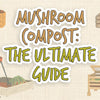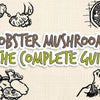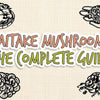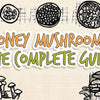Honey Mushrooms: The Complete Guide
Armillaria mellea, commonly known as honey fungus, is the largest division of mushrooms in the genus armillaria. But don't let the name fool you, the only thing that can be associated with honey in this mushroom is its golden hue.
Not Much Time? Skip To What You'd Like To Learn...
-
Honey Mushroom Fun Facts
-
Five Benefits Of Eating Honey Mushrooms
-
Types of Honey Mushrooms
-
How To Identify Honey Mushrooms
-
Honey Mushrooms False Lookalikes
-
Foraging for Honey Mushrooms
-
How To Grow Honey Mushrooms
-
Processing Honey Mushrooms
-
How to Preserve Honey Mushrooms
-
Honey Mushrooms Recipes and Cooking Guide
Honey Mushroom Fun Facts
-
Honey mushrooms are classified as plant pathogen as they usually cause armillaria root rot in many plant species.
-
The mushrooms are edible but do require some specialized preparation while cooking.
-
Some species are bioluminescent (they glow in the dark).
Five Benefits Of Eating Honey Mushrooms
The amounts in this section refer to 1 ounce (28g) of honey mushrooms.
1. Healthy Source of Natural Proteins and Vitamins
A single ounce of honey mushrooms contains as much as 4g of proteins. Vitamin C which is required in protein metabolism as well as being an essential component of connective tissues is also present in honey mushrooms (link).
2. Rich in Calories
Honey mushrooms can provide up to 30 calories which accounts for at least 1% daily value. This is in the form of carbohydrates which are a great source of energy (link).
3. Source of Dietary Fiber
Dietary fiber, in this case, refers to the roughage portion of the mushrooms that your body cannot digest. These play a vital role in bulking and maintenance of a healthy digestive system. For every ounce of honey mushrooms, you will get 1g of dietary fiber (link).
4. Contains Essential Minerals
Honey mushrooms contain calcium, iron and sodium minerals. Your body is always in constant demand for calcium with a sizable amount going towards maintenance of healthy bones and teeth. Honey mushrooms contain at least 40mg of calcium in every 1 ounce.
Iron plays a vital role in the formation of hemoglobin which is responsible for oxygen transportation. Honey mushrooms contain at least 0.9mg of iron.
Sodium helps in regulating the body's electrolyte balance. It also plays a vital role in muscle function as well as normal nerve functions (link).
5. Rich in Anti-Oxidants
Honey mushrooms are rich in anti-oxidants which are elements that slow down the deterioration of healthy body cells. This ensures that only the damaged cells get replaced (link).
Types of Honey Mushrooms
Armillaria Mellea
This is the most common variety and can be identified by its scaly cap and small stem rings. The cap is yellowish in color. The flesh, on the other hand, is firm and has a rich flavor. These mushrooms can have a slightly bitter taste which can cause gastric distress.
Armillaria Ostoyae
This variety is commonly referred to as dark honey fungus due to its distinctive dark brown hue and black scales. Another identifying characteristic is its persistent stem ring.
Armillaria Tabescens
Upon maturity, the gills of armillaria tabescens will turn pinkish-brown. The mushroom is identified by its lack of a stem ring hence its name ringless honey fungus.
Armillaria Gallica
Unlike other honey mushroom varieties, armillaria gallica has a bulbous stem. The mushroom also has a fleeing cobweb-like ring that becomes a yellowish ring on reaching maturity.
Pholiota Squarrosa
The squarrosa variety is covered in scales with an inrolled margin. The gills have a uniform red-brown color. The mushroom has a radish-like smell and after taste.
How To Identify Honey Mushrooms
Armillaria mellea has some of the most poisonous false lookalikes. Therefore, before you pick any mushroom that you suspect to be honey mushrooms make sure you can positively identify it. Here are some characteristics to look for:
Spore print - Honey mushrooms have a white spore print which helps to identify armillaria mellea from the deadly galerina marginata.
Gills - The gills are attached directly to the stem with some beginning to run down it.
Stem - Honey mushrooms have a long and whitish stem with a ring around its upper part. The ring covered the gills during its young stages.
Cap - Honey mushrooms have a convex cap that flattens out once it has matured. The caps are about 1-4 inches across with colors ranging from yellow to shades of brown.
Flesh - A freshly picked honey mushroom has whitish flesh with a slightly pinkish hue which does not change when sliced.
Odor and Taste - Honey mushrooms lack any distinctive odor and taste.
Touch - Honey mushrooms have small iridescent hairs on the caps.
Honey Mushrooms False Lookalikes
Galerina Marginata - This mushroom often grows on wood and in clusters with relatively small caps. The brown to tawny hue changes in age making it hard to tell apart by just comparing the colors. The best way to tell apart this mushroom and a honey mushroom is by observing the spore print. Galerina marginata has a red-brown spore print while the honey mushroom has a whitish spore print.
Pholiota Aurivella - Pholiota aurivella belongs to the genus pholiota. These mushrooms have brownish spore prints and gills that are attached to the stem but don't run down it. They also have smooth spores with pores, unlike the honey mushrooms which have small iridescent hairs.
Sulfur Tuft - These brown and tawny mushrooms have gills that attach to the stem. Again, the only way to tell apart this poisonous species from a honey mushroom is by doing a spore print whereby sulfur tufts have a purply brown spore print.
(link)
Foraging for Honey Mushrooms

The best way to obtain fresh honey mushrooms is by foraging for them in the woods. Here are a few pointers to find honey mushrooms:
Location - Honey mushrooms are prevalent across all continents. The colonies can be found around dead logs or growing on live trees which rot away in due time.
Season - Armillaria mellea usually blooms after the rainy season. In North America, the mushrooms are often in plentiful from late summer to fall.
Growth - Honey mushrooms grow in dense clusters and are found near or around hardwood trees.
After identifying a healthy patch of honey mushrooms, you should proceed to cut the batch using a mushroom knife. This helps to leave the mycelium intact for future growth.
When foraging we would always recommend using mushroom knife for ease of use, and a clean cut. Interested in learning more about mushroom knives? Click Here For The Complete Guide To Mushroom Knives
How To Grow Honey Mushrooms
Armillaria can be quite a bother to produce especially if there is a risk of it spreading to nearby trees. Such uncontrolled growth can destroy trees if left unchecked. The best way to grow honey mushrooms is in a controlled environment.
Due to its somewhat long mycelium growth stage, it's nearly impossible to find home growing kits that cater to honey mushrooms. The controlled environment process involves the following steps:
1. Pruning - This consists of identifying dead wood that's already infected by honey mushrooms. The wood is cut into sizeable chunks.
2. Mulching - In this process, the dead wood is mulched with rich compost and sprayed with nutrient-rich fish emulsion as well as seaweed.
3. Casing - In order to support the pinning mushrooms, a casing layer of soil is gently poured into the surface of the logs and compost substrate.
4. Pinning - The pinning process involves inducing fruiting by reducing carbon dioxide concentration and light. The process should be handled carefully as overdoing it could result in rot.
5. Cropping - This involves the management of harvest cycles whereby you should allow enough time for the mushrooms to regrow and add new logs if the previous ones are already covered up by mycelia.
Want to know our Top 10 Mushrooms Growing Kits? We have a full and comprehensive guide to the best growing kits and considerations before buying one too! Check out our Top 10 Mushroom Growing Kits Here.
Processing Honey Mushrooms

After harvesting your honey mushroom, the next action should be processing them. This involves steps such as:
Brushing - Using a soft bristled brush gently clean of any debris or dirt particles that might be clinging to your mushrooms.
Rinsing - In order to thoroughly clean honey mushrooms hold them under gently running water to remove any debris that might be trapped between the gills
Stem Removal - Honey mushrooms have a fibrous stem which renders it inedible. The stems are plucked and disposed of while the caps and gills are kept for cooking.
How to Preserve Honey Mushrooms
Drying - Honey mushrooms can be sun-dried for extended storage and reconstituted when needed to be consumed.
For a more comprehensive guide to drying mushrooms, check out our article here (link).
Pickling - Pickled honey mushrooms are quite agreeable in stews. You can pickle the mushrooms in your favorite spices for later use.
Check out our full article on pickling and canning mushrooms here (link).
Refrigeration - You can store your freshly foraged honey mushrooms in the refrigerator. It is recommended to consume them within the week.
For further information on storing your mushrooms (link) and freezing (link) them, check out our articles.
Honey Mushrooms Recipes and Cooking Guide
Honey mushrooms are highly admired for their firm and meaty texture. However, they do have a noticeable after taste and it's therefore advisable to prepare them with other ingredients rather than alone.
Honey mushrooms can lead to a gastric upset or leave a mildly bitter aftertaste. To avoid this the mushrooms, need to be parboiled for at least 5 minutes and the water discarded.
Spicy Honey Mushroom Relish
Inspired by Wild About Mushrooms (link).
Ingredients:
1lb parboiled honey mushrooms
1 cup dry sherry
salt to taste
3 tbsp butter
1 tsp ground nutmeg
1 tbsp brown sugar
1 tsp flour
1 tsp grated ginger
Directions:
1. Melt the butter in a heavy nonstick skillet.
2. Sauté the parboiled mushrooms for at least 7 minutes while avoiding tossing.
3. Blend in the spices, sugar, sherry, and flour and gently cook for 10 minutes.
4. Add salt and serve while hot.
Honey Mushrooms with Pork Stew
Inspired by Wild About Mushrooms (link).
Ingredients:
1lb mature parboiled honey mushroom caps
3 cups celery, cut into 1/4-inch thick slices
2 tbsp peanut oil
2 lb of lean pork, cut into cubes
1 lb bean sprouts
salt and pepper
2 tbsp flour mixed with cold water
1 cup of soy sauce
Directions:
1. Use a heavy pot to heat the oil and sear the pork cubes.
2. Remove the cubes when they turn golden brown.
3. Add the parboiled mushroom caps and simmer for at least 20 minutes.
4. Add soy sauce, celery, and flour water mixture and continue stirring gently for about 3 minutes.
5. Add bean sprouts and cover the pot, remove from heat and set aside for 5 minutes so that the bean sprouts can cook.
6. Add seasoning.
7. Best served with steamed white rice.
Honey Mushroom Salad
Inspired by Wild About Mushrooms (link).
Ingredients:
1lb parboiled honey mushroom caps
pinch of salt
3/4 cup water
2 tbsp soy sauce
1/4 cup black sesame seeds
4 tbsp of rice wine vinegar
1/4 cup dry sherry
1 napa cabbage cut into fine strips
Directions:
1. Boil water, mushrooms, and salt in a saucepan for at least 5 minutes. Drain.
2. Toast the sesame seeds using a dry skillet, keep stirring until they are fragrant.
3. Add in the oil, soy sauce, sherry, and vinegar with the sesame seeds.
4. Toss the mixture with the mushrooms before chilling slightly.
5. Best served on a bed of cabbage.
Honey Balsamic Garlic Mushrooms
Inspired by The Recipe Critic (link).
Ingredients:
16oz parboiled honey mushrooms
1 tbsp olive oil
1/4 cup balsamic vinegar
4 garlic cloves, minced
1 tbsp honey
freshly chopped parsley
salt and pepper
Directions:
1. Heat a nonstick skillet over medium-high heat and add the oil.
2. Add the parboiled mushrooms, salt, and pepper. Sauté until they become tender.
3. In a separate bowl whisk the balsamic vinegar, minced garlic, and honey.
4. Add the sauce to the honey mushrooms and cook until the mushrooms are well cooked.
5. Garnish with the freshly chopped parsley.
Honey Mushrooms in Sour Cream
Inspired by Forager Chef (link).
Ingredients:
8oz parboiled honey mushrooms
salt and pepper to taste
freshly chopped dill
1/4 cup dry sherry
2 tbsp unsalted butter
2 tbsp shallot diced into quarters
1 cup sour cream
Directions:
1. In a large skillet heat the butter and allow it to melt.
2. Add the parboiled mushrooms and sauté until browned.
3. Season with salt and pepper. Add the shallot and cook until it turns translucent.
4. Add the sherry to deglaze the pan until its nearly dry.
5. Add sour cream, dill and a little water to thin the sauce if need be.
6. Serve immediately.











